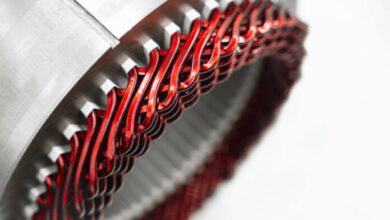The Global Market Trends of Ultrasonic Welding Suppliers

The global manufacturing sector is rapidly advancing, with ultrasonic welding becoming essential for precision and energy-efficient solutions. Various industries like automotive rely on ultrasonic welding suppliers to meet growing demands while driving innovation, sustainability, and automation.
This article examines the latest global trends influencing the ultrasonic welding industry and explores how ultrasonic welder manufacturers are adapting to these changes.
Key Global Market Trends Shaping the Industry
What factors are driving the rapid growth of the ultrasonic welding market? From environmental demands to technological breakthroughs, multiple trends are shaping the evolution of this industry. Suppliers and manufacturers must stay ahead of these developments to remain competitive while addressing the needs of diverse sectors.
1. Sustainability Driving Industry Standards
Sustainability is no longer a niche concern; it has become a business imperative. Across industries, companies are striving to reduce their carbon footprint, and ultrasonic welding is playing a significant role in this transition.
Why ultrasonic welding is sustainable:
- Energy Efficiency: Ultrasonic welding machines use high-frequency vibrations, consuming less energy compared to traditional methods like adhesive bonding or heat-based welding.
- Waste Reduction: By eliminating the need for consumables like adhesives or fasteners, ultrasonic welding reduces material waste.
- Recyclability: The technology is well-suited for recyclable materials, particularly in industries like packaging, where sustainability is a priority.
Ultrasonic welding suppliers are emphasizing these advantages to help their clients achieve sustainability goals. Many are also working closely with clients to perform lifecycle assessments of their welding systems, highlighting the environmental benefits.
2. Technological Innovation as a Competitive Edge
Advances in technology are shaping the offerings of ultrasonic welding equipment manufacturers, leading to systems that are smarter, faster, and more precise. These innovations are particularly critical in high-demand sectors like aerospace and medical devices.
Key technological advancements include:
- Artificial Intelligence (AI): AI enhances process control, optimizing welding parameters in real time to improve quality and minimize defects.
- IoT Integration: Sensors embedded in ultrasonic welding machines collect data on performance metrics, enabling predictive maintenance and reducing downtime.
- Advanced Monitoring Systems: Real-time feedback systems help operators monitor the quality of welds, ensuring consistent outcomes.
- 3D Ultrasonic Welding: This emerging technology allows welding of complex shapes and multi-material components, expanding the applications of ultrasonic welding.
Suppliers who focus on cutting-edge technologies, such as those offering versatile welding plastic solutions, are well-positioned to cater to industries prioritizing innovation and precision in their production processes.
3. Increased Use of Lightweight Materials
Lightweight materials are becoming essential in industries aiming to reduce costs and emissions. In particular, the automotive and aerospace sectors are adopting lightweight plastics and composites to improve efficiency.
Ultrasonic welding is ideal for these materials:
- It creates strong bonds without adding weight, unlike mechanical fasteners.
- The process is non-invasive, ensuring the material’s structural integrity.
Applications:
- Automotive: Interior panels, battery enclosures, and electronic components.
- Aerospace: Lightweight assemblies that demand durability and precision.
- Consumer Electronics: Compact devices requiring precise assembly.
Ultrasonic welding suppliers are continually refining their systems to cater to these materials. By offering custom solutions, they ensure optimal performance and compatibility with lightweight substrates.
4. Expanding Electronics and Medical Device Markets
The miniaturization of electronic components and medical devices has increased the demand for precision technologies like ultrasonic welding.
In electronics:
- Ultrasonic welding ensures strong, clean bonds for micro-components and flexible printed circuit boards (PCBs).
- It is widely used in the assembly of batteries, sensors, and connectors.
In medical devices:
- The process meets stringent hygiene standards, essential for products like surgical instruments, catheters, and diagnostic equipment.
- It eliminates the need for adhesives, reducing the risk of contamination.
By developing compact, highly reliable systems, ultrasonic welding machine manufacturers are positioning themselves as key players in these rapidly growing markets.
5. Automation and Industry 4.0 Integration
Automation is transforming manufacturing processes globally, and ultrasonic welding is no exception. Industry 4.0 principles are driving the adoption of fully automated systems that deliver unmatched efficiency and scalability.
Trends in automation:
- Integrated Systems: Ultrasonic welding systems are increasingly designed to work seamlessly with robotic assembly lines.
- Remote Monitoring: Cloud-based tools enable operators to monitor and control machines from remote locations, improving operational flexibility.
- Customization and Modularity: Modular designs allow manufacturers to scale production without overhauling existing infrastructure.
For ultrasonic welding equipment manufacturers, automation represents both a challenge and an opportunity to cater to modern production demands.
Regional Trends Shaping the Market
Asia-Pacific
The Asia-Pacific region dominates in automotive and electronics manufacturing, making it a key market for ultrasonic welding suppliers. Countries like China, India, and South Korea are leading the adoption of ultrasonic welding due to:
- Rapid industrialization.
- A growing consumer electronics market.
- Government initiatives supporting advanced manufacturing.
Europe
Europe’s focus on sustainability and advanced technologies drives demand for ultrasonic welding in packaging, automotive, and renewable energy sectors. Ultrasonic plastic welding machine manufacturers in the region are innovating to meet stringent environmental standards.
North America
North America continues to lead in aerospace and medical device manufacturing. The emphasis on precision and innovation ensures steady demand for high-quality solutions from ultrasonic welding machine manufacturers.
Challenges Facing Ultrasonic Welding Suppliers
While the ultrasonic welding market is experiencing significant growth, suppliers must navigate several challenges to maintain competitiveness and meet evolving industry demands. These challenges include:
1. Cost Management
With rising material costs and market competition, ultrasonic welding suppliers must balance innovation with affordability. Offering modular, scalable solutions helps customers maximize ROI while minimizing capital expenditure.
2. Material Shortages
Global supply chain disruptions have impacted the availability of specialized plastics and composites. Ultrasonic welding equipment manufacturers are working with material providers to develop alternatives that maintain product quality.
3. Skill Gaps
The advanced nature of modern ultrasonic welding machines requires skilled operators. Suppliers are addressing this issue by:
- Offering extensive training programs.
- Providing digital manuals and virtual simulations for operators.
The Role of Ultrasonic Welding Suppliers in Industry Growth
Suppliers are pivotal in enabling industries to adopt ultrasonic welding effectively. Ultrasonic welding suppliers are not just providing equipment—they are offering tailored solutions that address specific industry needs.
What differentiates leading suppliers?
- Innovation: Staying ahead with cutting-edge technologies.
- Customization: Offering tailored solutions for unique manufacturing challenges.
- Service Excellence: Ensuring robust after-sales support.
By focusing on these areas, ultrasonic welding machine manufacturers solidify their position as indispensable partners in global manufacturing.
Conclusion
The future of ultrasonic welding is promising, with trends like sustainability, automation, and technological innovation driving growth. As industries continue to prioritize precision and efficiency, the demand for ultrasonic welding suppliers will only increase.
For ultrasonic welding suppliers, the road ahead involves: Embracing AI and IoT to improve welding plastic machine capabilities; expanding globally to tap into emerging markets and strengthening partnerships to address material and skill challenges.



